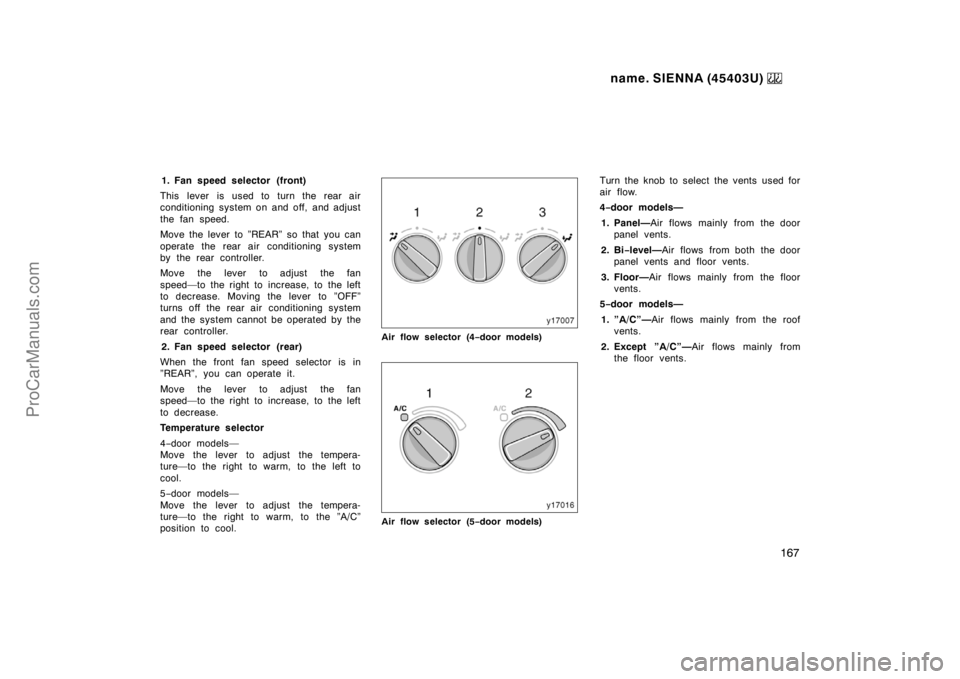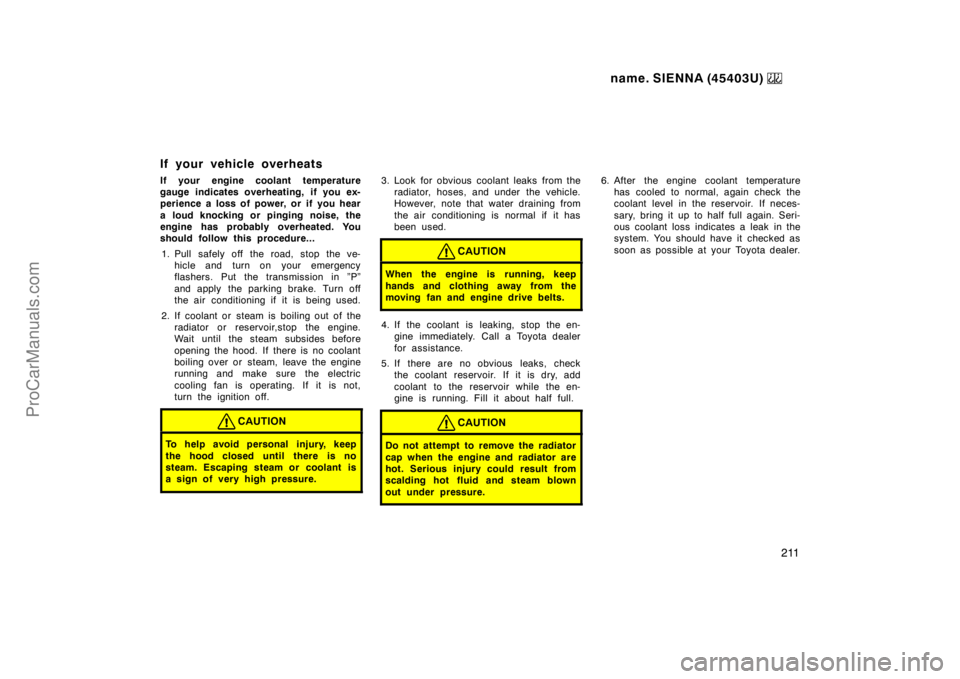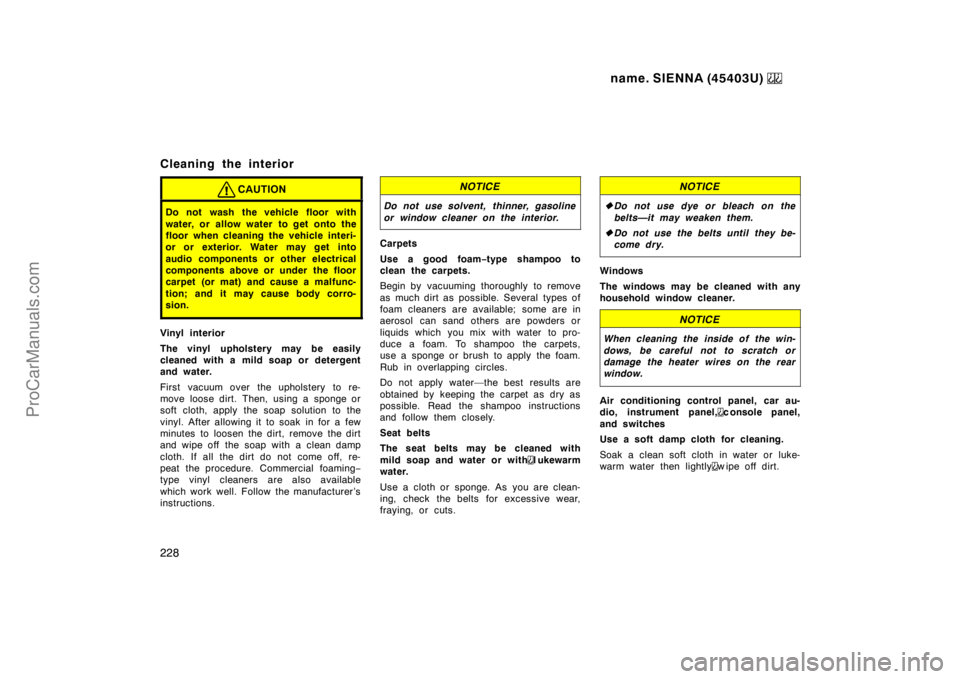Page 162 of 272
name. SIENNA (45403U)
162
—Air flow selector settings —Operating tips
�To cool off your Toyota after it has
been parked in the hot sun, drive with
the windows open for a few minutes.
This vents the hot air, allowing the air
conditioning to cool the interior more
quickly.
�Make sure the air intake grilles in front
of the windshield are not blocked (by
leaves or snow, for example).
�On humid days, do not blow cold air
on the windshield. The windshield could
fog up because of the difference in air
temperature on the inside and outside
of the windshield.
�Keep the area under the front seats
clear to allow air to circulate through-
out the vehicle.
�On cold days, move the fan speed to
”HI” for a minute to help clear the in-
take ducts of snow or moisture. This
can reduce the amount of fogging on
the windows.
ProCarManuals.com
Page 163 of 272

name. SIENNA (45403U)
163
Heating
For best results, set controls to:
Fan speed—Any setting except ”OFF”
Temperature—To w a r d s WARM
(red zone)
Air intake—FRESH (outside air)
Air flow—FLOOR
Air conditioning—OFF
�For quick heating, select recirculated
air for a few minutes. To keep the
windows from fogging, select fresh af-
ter the vehicle interior has been
warmed.
�Press the ”A/C” button on for dehumidi-
fied heating.
�Choose floor/windshield air flow to heat
the vehicle interior while defrosting or
defogging the windshield.Air conditioning
For best results, set controls to:
Fan speed—Any setting except ”OFF”
Temperature—To w a r d s COLD
(blue zone)
Air intake—FRESH (outside air)
Air flow—PANEL
Air conditioning—ON
�For quick cooling, move the air intake
selector to recirculate for a few min-
utes.
Ventilation
For best results, set controls to:
Fan speed—Any setting except ”OFF”
Temperature—To w a r d s COLD
(blue zone)
Air intake—FRESH (outside air)
Air flow—PANEL
Air conditioning—OFF
Defogging
The inside of the windshield
For best results, set controls to:
Fan speed—Any setting except ”OFF”
Temperature—To w a r d s WARM
(red zone) to heat;
COLD (blue zone) to
cool
Air intake—FRESH (outside air)
Air flow—WINDSHIELD
Turning the air flow control knob to wind-
shield position turns on the defroster−
linked air conditioning. This is to clean up
the front view more quickly.
When the ”A/C” button is not pressed in,
turning the air flow control knob to anoth-
er position turns off the air conditioning.
�On humid days, do not blow cold air
on the windshield—the difference be-
tween the outside and inside tempera-
tures could make the fogging worse.
ProCarManuals.com
Page 164 of 272
name. SIENNA (45403U)
164
Defrosting
The outside of the windshield
For best results, set controls to:
Fan speed—Any setting except ”OFF”
Temperature—To w a r d s WARM
(red zone)
Air intake—FRESH (outside air)
Air flow—WINDSHIELD
Turning the air flow control knob to wind-
shield position turns on the defroster−
linked air conditioning. This is to clean up
the front view more quickly.
When the ”A/C” button is not pressed in,
turning the air flow control knob to anoth-
er position turns off the air conditioning.
�To heat the vehicle interior while de-
frosting the windshield, choose
floor/windshield air flow.
—Side vents
Driver’s side
Passenger’s side
If air flow control is not satisfactory, check
the side vents. The side vents may be
opened or closed as shown.
ProCarManuals.com
Page 165 of 272
name. SIENNA (45403U)
165
1. Fan speed selector (front)
2. Fan speed selector (rear)
3. Air flow selector
4. Temperature selector
Rear air conditioning system—
—Controls
�4−door models
ProCarManuals.com
Page 167 of 272

name. SIENNA (45403U)
167
1. Fan speed selector (front)
This lever is used to turn the rear air
conditioning system on and off, and adjust
the fan speed.
Move the lever to ”REAR” so that you can
operate the rear air conditioning system
by the rear controller.
Move the lever to adjust the fan
speed—to the right to increase, to the left
to decrease. Moving the lever to ”OFF”
turns off the rear air conditioning system
and the system cannot be operated by the
rear controller.
2. Fan speed selector (rear)
When the front fan speed selector is in
”REAR”, you can operate it.
Move the lever to adjust the fan
speed—to the right to increase, to the left
to decrease.
Temperature selector
4−door models—
Move the lever to adjust the tempera-
ture—to the right to warm, to the left to
cool.
5−door models—
Move the lever to adjust the tempera-
ture—to the right to warm, to the ”A/C”
position to cool.
Air flow selector (4−door models)
Air flow selector (5−door models)
Turn the knob to select the vents used for
air flow.
4−door models—
1. Panel—Air flows mainly from the door
panel vents.
2. Bi−level—Air flows from both the door
panel vents and floor vents.
3. Floor—Air flows mainly from the floor
vents.
5−door models—
1. ”A/C”—Air flows mainly from the roof
vents.
2. Except ”A/C”—Air flows mainly from
the floor vents.
ProCarManuals.com
Page 203 of 272
![TOYOTA SIENNA 1999 Owners Manual name. SIENNA (45403U)
203 �
Because of the added load of the trail-
er, your vehicle’s engine may overheat
on hot days (at temperatures over
30�C [85�F]) when going up a long or
steep grade with a TOYOTA SIENNA 1999 Owners Manual name. SIENNA (45403U)
203 �
Because of the added load of the trail-
er, your vehicle’s engine may overheat
on hot days (at temperatures over
30�C [85�F]) when going up a long or
steep grade with a](/manual-img/14/58486/w960_58486-202.png)
name. SIENNA (45403U)
203 �
Because of the added load of the trail-
er, your vehicle’s engine may overheat
on hot days (at temperatures over
30�C [85�F]) when going up a long or
steep grade with a trailer. If the engine
coolant temperature gauge indicates
overheating, immediately turn off the air
conditioning (if in use), pull off the road
and stop in a safe spot. Refer to ”If
your vehicle overheats” in Part 4 of
this manual.
�Always place wheel blocks under both
the vehicle and trailer wheels when
parking. Apply the parking brake firmly.
Put the transmission in ”P”. Avoid park-
ing on a slope with a trailer, but if it
cannot be avoided, do so only after
performing the following:
1. Apply the brakes and hold.
2. Have someone place wheel blocks un-
der both the vehicle and trailer wheels.
3. When the wheel blocks are in place,
release your brakes slowly until the
blocks absorb the load.
4. Apply the parking brake firmly.
5. Shift into ”P” and turn off the engine.When restarting out after parking on a
slope:
1. With the transmission in ”P” position,
start the engine. Be sure to keep the
brake pedal depressed.
2. Shift into gear.
3. Release the parking brake and brake
pedal and slowly pull or back away
from the wheel blocks. Stop and apply
your brakes.
4. Have someone retrieve the blocks.
CAUTION
�Do not exceed 72 km/h (45 mph) or
the posted towing speed limit,
whichever is lower. Because insta-
bility (swaying) of a towing vehicle−
trailer combination usually in-
creases as the speed increases, ex-
ceeding 72 km/h (45 mph) may
cause loss of control.
�Slow down and downshift before
descending steep or long downhill
grades. Do not make sudden down-
shifts.
�Avoid holding the brake pedal down
too long or too frequently. This
could cause the brakes to overheat
and result in reduced braking effi-
ciency.
ProCarManuals.com
Page 211 of 272

name. SIENNA (45403U)
211
If your vehicle overheats
If your engine coolant temperature
gauge indicates overheating, if you ex-
perience a loss of power, or if you hear
a loud knocking or pinging noise, the
engine has probably overheated. You
should follow this procedure...
1. Pull safely off the road, stop the ve-
hicle and turn on your emergency
flashers. Put the transmission in ”P”
and apply the parking brake. Turn off
the air conditioning if it is being used.
2. If coolant or steam is boiling out of the
radiator or reservoir,stop the engine.
Wait until the steam subsides before
opening the hood. If there is no coolant
boiling over or steam, leave the engine
running and make sure the electric
cooling fan is operating. If it is not,
turn the ignition off.
CAUTION
To help avoid personal injury, keep
the hood closed until there is no
steam. Escaping steam or coolant is
a sign of very high pressure.
3. Look for obvious coolant leaks from the
radiator, hoses, and under the vehicle.
However, note that water draining from
the air conditioning is normal if it has
been used.
CAUTION
When the engine is running, keep
hands and clothing away from the
moving fan and engine drive belts.
4. If the coolant is leaking, stop the en-
gine immediately. Call a Toyota dealer
for assistance.
5. If there are no obvious leaks, check
the coolant reservoir. If it is dry, add
coolant to the reservoir while the en-
gine is running. Fill it about half full.
CAUTION
Do not attempt to remove the radiator
cap when the engine and radiator are
hot. Serious injury could result from
scalding hot fluid and steam blown
out under pressure.
6. After the engine coolant temperature
has cooled to normal, again check the
coolant level in the reservoir. If neces-
sary, bring it up to half full again. Seri-
ous coolant loss indicates a leak in the
system. You should have it checked as
soon as possible at your Toyota dealer.
ProCarManuals.com
Page 228 of 272

name. SIENNA (45403U)
228
Cleaning the interior
CAUTION
Do not wash the vehicle floor with
water, or allow water to get onto the
floor when cleaning the vehicle interi-
or or exterior. Water may get into
audio components or other electrical
components above or under the floor
carpet (or mat) and cause a malfunc-
tion; and it may cause body corro-
sion.
Vinyl interior
The vinyl upholstery may be easily
cleaned with a mild soap or detergent
and water.
First vacuum over the upholstery to re-
move loose dirt. Then, using a sponge or
soft cloth, apply the soap solution to the
vinyl. After allowing it to soak in for a few
minutes to loosen the dirt, remove the dirt
and wipe off the soap with a clean damp
cloth. If all the dirt do not come off, re-
peat the procedure. Commercial foaming−
type vinyl cleaners are also available
which work well. Follow the manufacturer ’s
instructions.
NOTICE
Do not use solvent, thinner, gasoline
or window cleaner on the interior.
Carpets
Use a good foam−type shampoo to
clean the carpets.
Begin by vacuuming thoroughly to remove
as much dirt as possible. Several types of
foam cleaners are available; some are in
aerosol can sand others are powders or
liquids which you mix with water to pro-
duce a foam. To shampoo the carpets,
use a sponge or brush to apply the foam.
Rub in overlapping circles.
Do not apply water—the best results are
obtained by keeping the carpet as dry as
possible. Read the shampoo instructions
and follow them closely.
Seat belts
The seat belts may be cleaned with
mild soap and water or with
l ukewarm
water.
Use a cloth or sponge. As you are clean-
ing, check the belts for excessive wear,
fraying, or cuts.
NOTICE
�Do not use dye or bleach on the
belts—it may weaken them.
�Do not use the belts until they be-
come dry.
Windows
The windows may be cleaned with any
household window cleaner.
NOTICE
When cleaning the inside of the win-
dows, be careful not to scratch or
damage the heater wires on the rear
window.
Air conditioning control panel, car au-
dio, instrument panel,
c onsole panel,
and switches
Use a soft damp cloth for cleaning.
Soak a clean soft cloth in water or luke-
warm water then lightly
w ipe off dirt.
ProCarManuals.com